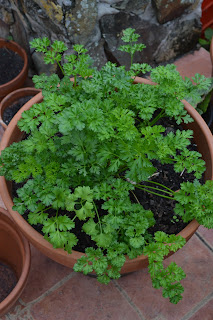 |
| Sprouted Mung Beans |
Sprouts are nutrient dense and take up almost no space. If you want fresh veggies without having to grow a garden, sprouts are the way to go. Do you know that a small box of Alfalfa sprouts at the grocery store cost about $4. That's ridiculous!
For $8 you can get 8 ounces of seeds, which will make about 20 boxes of sprouts. Most important, by growing your own you are in control of your food. You can decide when to grow, how much to grow and grow them organically.
Don't be scared to try something new. Don't let Sprouts intimidate you. Take control of your food! (Fist in the air, that's me the drama queen) Seriously, it's not difficult and it's good for you. Don't believe me? Below are the facts:
Alfalfa sprouts according to LiveStrong:
Alfalfa sprouts contain only 8 calories per serving, making
this crunchy food an ideal choice for people who are trying to lose weight.
Self magazine grants alfalfa sprout a five-star rating as a weight loss aid,
noting that it is low in calories, sugar, fat and saturated fat. Additionally,
because alfalfa sprouts are rich in fiber and protein, they may help to
facilitate sensations of fullness for people who tend to overeat.
Alfalfa sprouts are a good source of several micronutrients,
or vitamins. NutritionData reports that alfalfa sprouts contain B vitamins such
as niacin, thiamin, riboflavin, folate, pantothenic acid and vitamin B6.
Additionally, alfalfa sprouts provide roughly 13 percent of an adult's
recommended daily intake of vitamin K. Because of alfalfa's high vitamin K
content, the National Institutes of Health advise patients taking blood-thinners
to avoid foods and supplements made from the plant.
Broccoli sprouts according to Livestrong:
Eating broccoli sprouts may be able to protect people from cancer, according to scientists from Johns Hopkins. The Maryland-based researchers found that young broccoli sprouts contain a substance called sulforaphane in concentrated amounts. Sulforaphane helps the body fight cancer, and may prevent certain cancers from developing. Researchers call this phenomenon chemoprotection.
Asthma sufferers may benefit from a daily dose of broccoli
sprouts, as studies have shown a decrease in inflammation of the airways after
eating the vegetable. A study reported in the March 2009 issue of Clinical
Immunology reports that sulforaphane, the same compound that can prevent and
fight cancer, reduced inflammation associated with asthma and nasal allergies.
In addition to broccoli sprouts, sulforaphane is naturally occurring in
cauliflower, mature broccoli, brussels sprouts and cabbage.
Fenugreek sprouts according to Livestrong:
Fenugreek sprouts provide a large source of protein and a
smaller amount of carbohydrates due to the sprouting process compared to other
legumes. The soaking process of seed to sprout allows for enzymatic reactions
to occur, providing easily digested proteins. The enzyme amylase breaks down
complex carbohydrates found in the seeds to simple carbohydrates that are
washed away during the rinsing process. Lipase, an enzyme that breaks down fat,
creates a usable form of fat that is easily absorbed in the body.
Fenugreek can be used as spice, digestive aid, hair growth
supplement and expectorant. Fenugreek may help stimulate milk production in
nursing women and may aid in menopausal symptoms such as hot flashes and breast
tenderness. Fenugreek may also help to naturally lower cholesterol and aid in
blood-sugar control in people who have diabetes.
Fenugreek provides a variety of vitamins, minerals,
proteins, healthy fats and fiber. One teaspoon of fenugreek contains 12
calories, 0.85 g protein, 0.24 g fat, 0.9 g fiber, 7 mg calcium, 1.24 mg iron,
7 mg magnesium, 11 mg phosphorus and 28 mg potassium.
Mung Bean sprouts according to Livestrong:
Mung bean sprouts have a low calorie density, or energy density, with only 31 calories per 104 g serving. Low energy-dense foods can help you lose weight or prevent weight gain because they are relatively low in calories compared to their serving size, so you can fill up on them without eating too many calories, according to MayoClinic.com. Low energy-dense foods tend to be low in fat and high in dietary fiber, and mung bean sprouts have almost no fat and nearly 2 g dietary fiber per serving.
Each cup, or 104 g serving, of sprouted raw mung beans
provides 155 mg potassium and only 6 mg sodium. Try to get at least 4,700 mg
potassium and no more than 2,300 mg sodium per day to avoid high blood pressure
and an increased risk for heart disease, stroke and kidney disease, according
to the 2010 Dietary Guidelines from the U.S. Department of Health and Human
Services.
Each 1-cup serving of raw mung bean sprouts provides 14 mg
vitamin C, or nearly one quarter of the daily value for vitamin C. Vitamin C is
an antioxidant vitamin that is essential for proper immune function and wound
healing. Another benefit of mung bean sprouts is their 60 mcg folic acid, or 15
percent of the daily value for this B vitamin, which is an especially important
nutrient for women who may become pregnant, because it reduces the risk for
neural tube birth defects.
A benefit of mung bean sprouts is that more than 90 percent
of their weight is water, and you can use them, like other vegetables, to help
you stay hydrated, according to the University
of Michigan. Mung bean
sprouts are a cholesterol-free food, and their dietary fiber can lower levels
of bad LDL cholesterol in your blood.
Sign up for our E-Newsletter








































